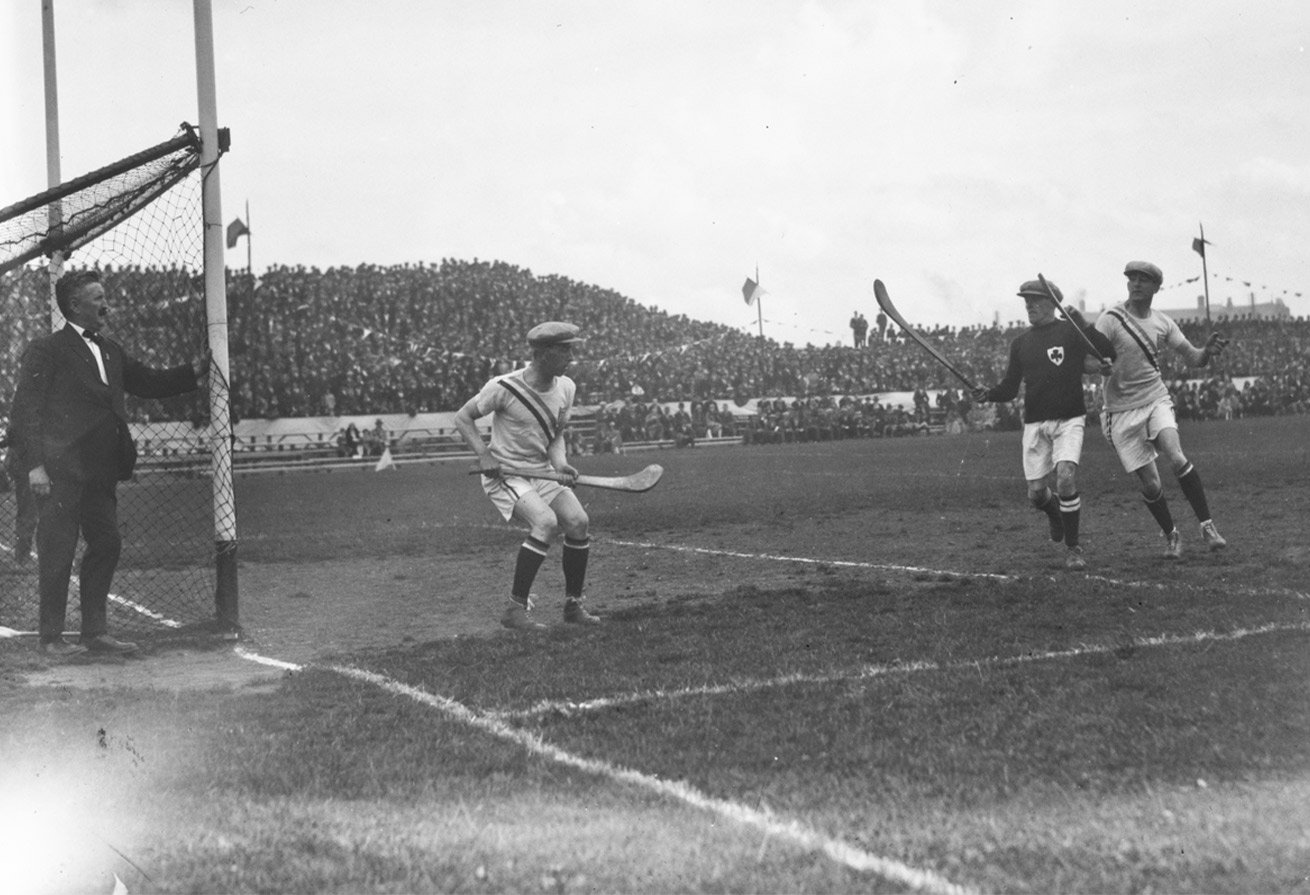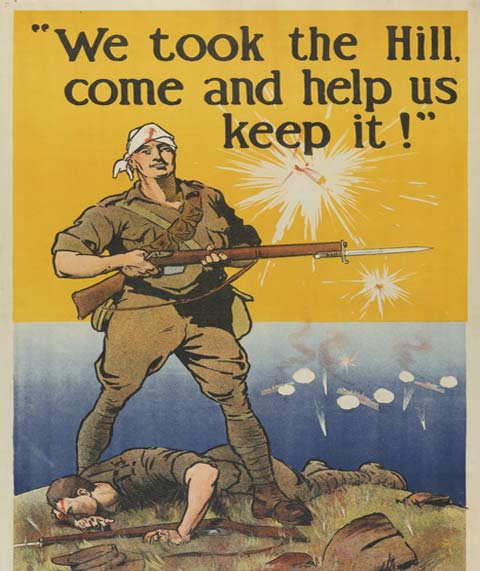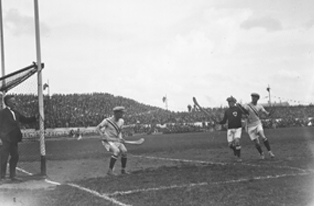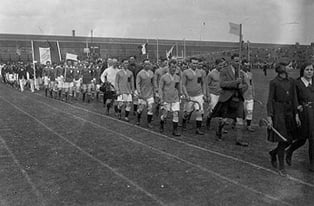


After the August landings at Suvla Bay and the failure of the allies to successfully move inland, a decision was made for an all-out attack on Scimitar Hill and Hill 60. If these targets were taken the allies would have been able to link together their strongholds at Suvla Bay and ANZAC Cove. The attack on Hill 60 comprised a mixed force under the command of Major-General Herbert Cox. It was composed of the New Zealand Mounted Rifles who would attack the hill itself, the Gurkhas who would attack the wells at Susak Kuyu and 700 men of the 5th Battalion of the Connaught Rangers who would attack the wells at Kabak Kuyu. The operation would be supported by troops from the Australian 4th Infantry Brigade and the 10th Hampshires who would mount a feint attack to occupy Turkish reserve forces. The problem for the allied forces attacking Hill 60 was that since the Suvla Bay landings the Turks had fully entrenched themselves at the summit, and it would not be easily taken.
After the initial attacks on the Turkish positions on 21 August the allied forces dug trenches into Hill 60. What followed was a period of firing and shelling from both sides until allied commanders ordered a fresh attack on the summit of Hill 60 on 27 August. The attempt to take the summit continued for two days. The allies failed to take the summit of Hill 60, although they did take a number of Turkish trenches. The Connaught Rangers were again involved in the attack and endured fierce hand to hand fighting in a Turkish counter attack. The failure to take Hill 60 meant that the Turks still held the elevated position overlooking Suvla Bay and would be able to continue shelling allied positions from there until the end of the campaign.
It is estimated that the Connaught Rangers suffered 198 casualties during the first day of attacks on Hill 60, with nearly 90 men being killed.
Having purchased a ground on Jones Road in Dublin in December 1913, the GAA named that ground Croke Memorial Park and set about redeveloping the stadium. By the time of the GAA’s annual convention in April 1915, the association’s secretary Luke O’Toole was able to report that the wall at the Railway End had been built and that the enclosure on the side of the pitch facing Jones Road was almost complete, as was the banking behind the bottom goals: that is, the area now known as Hill 16. The work was complete by the playing of the All-Ireland finals late in 1915.
At the very moment that Croke Park was being redeveloped, ‘Hill 60’ was emblazoned in newspaper headlines and was documented in letters home from the front that were reprinted in the Dublin press. The redeveloped corner of Croke Park was considered to resemble the description of Hill 60, and soon after, that part of the ground became known as ‘Hill 60’. There was already precedence for this of course. Several English soccer grounds used the term Spion Kop (or Kop for short) to describe their terraces; the logic was that their steep nature was evocative of a hill near Ladysmith, South Africa, where the Battle of Spion Kop was fought in January 1900 during the Second Boer War. This happened at soccer grounds such as Anfield, Hillsborough and others.
Either way, Hill 60 was born and it lived through the 1916 Rising, the War of Independence, Bloody Sunday and more. It was known as such, for example, in a newspaper report which described the atmosphere in Croke Park while Kevin Barry was being executed in October 1920. Newspaper reportage on GAA matches through the 1920s regularly note the great crowds which congregated on Hill 60, with the Irish Independent noting in September 1925 that it was ‘a living mountain of human faces'. It is not just the Dublin papers that referred to it as Hill 60, the same was the case for local papers such as the Munster Express and the Connacht Tribune. There appears to be no official documentation in which the name Hill 60 was used, rather it is something which appears time and again in newspaper reports.


The use of the name Hill 60 was a matter of disquiet to some members of the GAA. It is reasonable to suggest that this disquiet existed for some time before it surfaced publicly for the first time at a meeting of the Central Council of the Association in September 1931. Dan McCarthy, a former President of the GAA and then Chairman of the Munster Council, said that he took exception to the use of the name Hill 60. He said that Croke Park was ‘sacred ground… sanctified by the blood of martyrs’. The fight for Irish freedom should be commemorated, McCarthy argued, rather than one that ‘took place in a foreign country, fought by a foreign army’. In response to McCarthy’s words, the secretary of the GAA told the meeting that he had already drawn the attention of the newspaper to the matter. The meeting agreed that whenever he found the name Hill 60 used, he should draw newspaper’s attention to the association’s disapproval. Finally, McCarthy said that they should call it Hill 16, but that if they couldn’t, they should find some other appropriate title.
They called it Hill 16. Advertisements around matches now set out the charges for spectators entering Hill 16. The pressure on the newspapers was also successful and in that same month of September 1931 of the GAA meeting where McCarthy had raised his objections to the Hill 60 name, The Irish Press newspaper was published for the first time. It always referred to Hill 16; only once did it use the term Hill 60 in connection with Croke Park, and even then the paper apologised the following day.
It was one thing, of course, to change the name; it was another to change its origin myth and it took the rest of the decade for the full foundations of the myth to be set out. When the Cusack Stand was opened in August 1938 in honour of the founder of the GAA, Michael Cusack, the then president of the GAA, Pádraig MacNamee said in a speech that Hill 16 was ‘an ever constant reminder of the gallant band who made the supreme sacrifice that this land of theirs might be Gaelic and free’. The first mention of the rubble of the 1916 Rising being used in the redevelopment comes from a letter from ‘Two Gaels’ to the editor of the Meath Chronicle. These men in urging Meath to victory in an All-Ireland Final in 1939, note that the team will be facing the tricolor that will fly above Hill 16 during the playing of the National Anthem ‘in respect to Ireland’s fallen heroes, whose blood stains the debris in that immortal hill’. And so the story began to take hold; it was repeated in the newspapers and eventually hardened into fact: Hill 16 had been built from the rubble of the 1916 Rising.